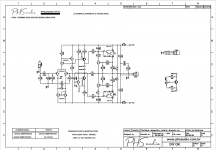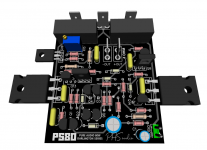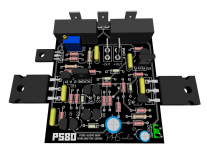Hello friends.
After a long time without posting due to work and other problems I bring a new amplifier that is still being developed and tested.
The PS80 darlington series is a small amplifier with darlington transistors at the output for a very simple purpose: to push my bass.
Simulator tests (the circuit is not yet definitive) have shown excellent performance at high frequencies as well, but I will use it to push my bass speakers.
I will still manufacture the pcb, 'tune' the amplifier and after that do the test using a QA401 audio analyzer, from QuantAsylum to better see the behavior of THD, IMD and the like.
Here in Brazil as always very hot and with good music !!! Hugs
(Paulo from PHS Audio)
Follows the provisional and still pending adjustment of values

View attachment PS80-NOVO-OPEN.pdf

After a long time without posting due to work and other problems I bring a new amplifier that is still being developed and tested.
The PS80 darlington series is a small amplifier with darlington transistors at the output for a very simple purpose: to push my bass.
Simulator tests (the circuit is not yet definitive) have shown excellent performance at high frequencies as well, but I will use it to push my bass speakers.
I will still manufacture the pcb, 'tune' the amplifier and after that do the test using a QA401 audio analyzer, from QuantAsylum to better see the behavior of THD, IMD and the like.
Here in Brazil as always very hot and with good music !!! Hugs
(Paulo from PHS Audio)
Follows the provisional and still pending adjustment of values

View attachment PS80-NOVO-OPEN.pdf

Last edited:
Nice design.
I used the TIP 147/TIP142 in a hybrid amp design myself. However, I coupled the output to the collectors rather than the emitters. This allowed me to add simple overcurrent sensing and limiting. I call this the "Tube Buffer". It has voltage gain of one. It requires a rail to rail voltage swing on the input which is quite easy to get with a tube preamp. The input Z is high enough I can couple a tube preamp with a relatively small capacitor. I did this primarily to save weight as it gets rid of the heavy tube output transformer. This performs well even without negative global feedback.
I used the TIP 147/TIP142 in a hybrid amp design myself. However, I coupled the output to the collectors rather than the emitters. This allowed me to add simple overcurrent sensing and limiting. I call this the "Tube Buffer". It has voltage gain of one. It requires a rail to rail voltage swing on the input which is quite easy to get with a tube preamp. The input Z is high enough I can couple a tube preamp with a relatively small capacitor. I did this primarily to save weight as it gets rid of the heavy tube output transformer. This performs well even without negative global feedback.
Attachments
Hybrid? Nice!!!
Dear campsquire, your project is very interesting. In Brazil we don't see many hybrids. I never particularly worked with tubes. But I think it's cool who designs and assembles. 🙂
Dear campsquire, your project is very interesting. In Brazil we don't see many hybrids. I never particularly worked with tubes. But I think it's cool who designs and assembles. 🙂
Here in Brazil it is very difficult to find good transformers for tubes. Those you have are very expensive and end up making the whole project unfeasible. Not to mention that tubes have to be imported and the majority that are around here are poor quality Chinese tubes.
I once made a small Darlington stereo amplifier using cheap TIP100/105.
HERE. Yours is simple and elegant. Mine is ugly but I do recall that that amp sounded really sweet. It was a stepping stone towards my later models and it proved to me that Darlingtons can and do make great amplifiers.🙂
but I do recall that that amp sounded really sweet. It was a stepping stone towards my later models and it proved to me that Darlingtons can and do make great amplifiers.🙂
Looking back, I think I had too much time on my hands.🙄

HERE. Yours is simple and elegant. Mine is ugly
 but I do recall that that amp sounded really sweet. It was a stepping stone towards my later models and it proved to me that Darlingtons can and do make great amplifiers.🙂
but I do recall that that amp sounded really sweet. It was a stepping stone towards my later models and it proved to me that Darlingtons can and do make great amplifiers.🙂Looking back, I think I had too much time on my hands.🙄


I've developed many amplifiers using common bjts on the output like the 2SC5200 / 2SA1943, but this is one of the first ventures in a Darlington. Another time, I started another project but I ran out of time and abandoned it due to too much oscillation. Now I'm ready for the next try ��
I made a Darlington amp once with conventional EF follower circuit (not HEC) and found that the Vbe multiplier has to account for the Tc of both output and driver since they are always at the same temperature and are cascade. So Vbe1 X Vbe2 should be compensated by a Darlington Vbe multiplier or bias won't track very well, can runaway.  There are some suitable Darlington in TO-126 if you can get them.
There are some suitable Darlington in TO-126 if you can get them.
 There are some suitable Darlington in TO-126 if you can get them.
There are some suitable Darlington in TO-126 if you can get them.- Home
- Amplifiers
- Solid State
- PS80 - Small 80W darlington amplifier

